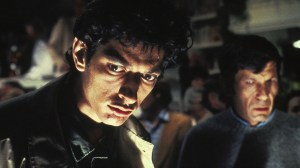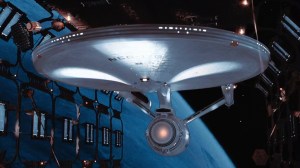Doctor Who returned on Saturday with the first of its three 60th-anniversary specials, “The Star Beast.” Doctor Who confirmed that returning showrunner Russell T. Davies wrote the special’s script. However, the credits also give the story credit to two legends of the comics industry: writer Pat Mills, sometimes called “the godfather of British comics” for co-creating 2000 AD, and Dave Gibbons, the artist of Watchmen. Mills and Gibbons collaborated on the original comic book story “Doctor Who and the Star Beast” that ran in issues of Doctor Who Weekly in 1980. It’s one of the best-loved Doctor Who comic stories of all time, and Davies and Doctor Who star David Tennant both shared fond memories of reading it as children. And, in a bit of trivia that may be weird to modern comics fans, it was published by Marvel Comics. [UPDATE: While the live-action poster for “The Star Beast” already was a clear homage to the cover of Marvel’s Doctor Who #1, the BBC commissioned and released new artwork by Butcher Billy that makes the reference by drawing the characters from the live-action special in comic book cover style. We’ve added the cover to the story below.]
Videos by ComicBook.com
From 1972 to 1995, Marvel had an imprint called Marvel UK. This imprint existed primarily to bring Marvel’s superhero comics stories to readers in the United Kingdom, but it also published original material, licensed comics, and magazines. Marvel UK founded Doctor Who Weekly in 1979, and the publication has outlived Marvel UK as today’s Doctor Who Magazine. The magazine included serialized Doctor Who comics in each issue, introduced during the Marvel UK days in classic Marvel style as “Stan Lee Presents Doctor Who,” but written in an episodic format similar to 2000 AD stories. Some of Britain’s top comics talent cut their teeth writing stories about the Doctor for Doctor Who Weekly, including Alan Moore, Bryan Hitch, and Grant Morrison. The tradition continues today with comics in Doctor Who Magazine, including “Liberation of the Daleks,” the first story to feature the Fourteenth Doctor, released even before “The Star Beast” special.

What is “Doctor Who and the Star Beast?”
Mills, Gibbons, and John Wagner (co-creator of Judge Dredd) were the regular creatives behind Doctor Who Weekly’s comics when the magazine first launched. Mills and Wagner had submitted the idea for “Doctor Who and the Star Beast” as a Doctor Who television episode. The BBC rejected it. Rather than let the idea go to waste, they reworked it as a story for Doctor Who Weekly. Gibbons has said that while Mills and Wagner always received joint credit for their Doctor Who Weekly stories, they took turns writing the comics. “Doctor Who and the Star Beast” was one of Mills’ scripts and presumably explains why he got credit for the Doctor Who special and not Wagner.
The main thrust of the comic story is almost identical to what appeared in “The Star Beast” television episode. A cute alien, Beep the Meep, crash-lands on Earth and seeks help from local human children to evade capture by the much scarier aliens called the Wrarth Warriors. The Doctor gets involved, and it turns out that looks can be deceiving as the Meep is a sadistic tyrant, while the Wrarth Warriors are good-natured beings looking to restore peace to the regions of space the Meep has conquered. It’d be a clever inversion of expectations set by E.T. the Extra-Terrestrial if “Doctor Who and the Star Beast” didn’t predate Steven Spielberg’s iconic family film by two years.

How is “Doctor Who and the Star Beast” in comics different from the Doctor Who 60th Anniversary Special?
A few key differences exist between the comic book and television versions of “The Star Beast.” The most obvious is that the comic book featured the Fourth Doctor (played by Tom Baker in the television series), while the 60th-anniversary special featured David Tennant as the Fourteenth Doctor. Both versions see the Doctor traveling without a companion (other than K-9, his faithful robotic dog, in the Fourth Doctor’s case). However, the Fourteenth Doctor is drawn back to a former companion in Donna Noble, while the Fourth Doctor makes a new friend.
Rather than Rose Noble, he original Star Beast story sees Meep befriending two school children: Fudge Higgins and Sharon Davies. Fudge is a science fiction fan who is immediately taken by rumors of a crashed alien ship at the steel mill. Sharon is a clever girl but not as up on the sci-fi stuff as Fudge, which makes it a little ironic that she’s the one to stick with the Doctor at the end of “Doctor Who and the Star Beast,” becoming the first companion created for Doctor Who comics. She’s also the first person of color to become a recurring companion to the Doctor in any Doctor Who media, predating the debuts of Mickey Smith and Martha Jones by decades.
There’s also a significant change to how the story is told in how the Meep’s true nature is revealed. In the Doctor Who television special, the truth about the Meep comes out in a trial presided over by the Doctor after he’s begun to suspect the Meep isn’t being honest. In the comic, the Meep’s betrayal is known to the reader much earlier because he has an internal monologue. It becomes a running gag that he’s thinking of murdering Fudge and Sharon the entire time he’s playing up the cute and helpless angle.
On the first episode of The Official Doctor Who Podcast, Davies said he kept that bit in his original script for “The Star Beast,” but others involved in the show’s production felt that the reveal came too early that way. He agreed to rewrite the script to keep the twist hidden longer, but he still wonders if it was the right choice.
Is this the last we’ve seen of the Meep on Doctor Who?
By the end of “The Star Beast,” the Meep is defeated and taken into custody by the Wrarth Warriors. He disappears with a threat against the Doctor, saying he’ll tell “the boss” about the Doctor. We don’t know who “the boss” is (The Toymaker, maybe?), but we have to wonder if this is the last we’ve seen of the Meep in Doctor Who.
That wasn’t the case in the comics. Beep the Meep makes appearances in other Doctor Who comic stories like “Party Animals” and “TV Action!” and the Big Finish audio drama “The Ratings War.” Writer Gary Gillatt, artist Gary Gillatt, and colorist Paul Vyse created a direct sequel to “Doctor Who and the Star Beast,” titled “Star Beast II,” published in Doctor Who Yearbook 1996. The story sees the Meep released on parole after 15 years of incarceration. He immediately returns to Earth to retrieve a deadly weapon he’d hidden near where he landed in the original tale. Unluckily for him, the Fourth Doctor is in the area again. The Doctor reunites with Fudge to stop the Meep once more. Whether we ever see this story turned into television remains to be seen.
How to Read “Doctor Who and the Star Beast” and How to Watch Doctor Who
Unfortunately, the complicated rights around the publication of Doctor Who comics means finding “Doctor Who and the Star Beast” can be challenging. The story isn’t available digitally but was colorized and reprinted in multiple collections. The story appears in UK publisher Panini Comics’ Doctor Who: The Iron Legion collection, the first volume of the publisher’s series reprinting classic Doctor Who Weekly stories. Stateside, IDW Publishing included it in its similar collections, Doctor Who Classics Volume 1 and Doctor Who Omnibus Volume 1. Unfortunately, these volumes are all out of print, meaning they can be scarce and pricey, but it’s always worth checking your local library if you have one and looking into an interlibrary loan.
The Doctor Who 60th-anniversary specials are airing on three consecutive Saturdays. Doctor Who debuts Saturday, December 2nd on the BBC and Disney+. The final Doctor Who 60th-anniversary special, “The Giggle,” will premiere on December 9th.








